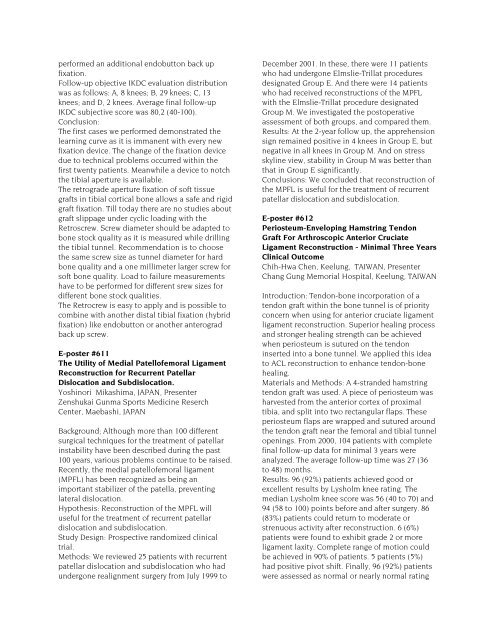POSTER ABSTRACTS - ISAKOS
POSTER ABSTRACTS - ISAKOS
POSTER ABSTRACTS - ISAKOS
You also want an ePaper? Increase the reach of your titles
YUMPU automatically turns print PDFs into web optimized ePapers that Google loves.
performed an additional endobutton back up<br />
fixation.<br />
Follow-up objective IKDC evaluation distribution<br />
was as follows: A, 8 knees; B, 29 knees; C, 13<br />
knees; and D, 2 knees. Average final follow-up<br />
IKDC subjective score was 80,2 (40-100).<br />
Conclusion:<br />
The first cases we performed demonstrated the<br />
learning curve as it is immanent with every new<br />
fixation device. The change of the fixation device<br />
due to technical problems occurred within the<br />
first twenty patients. Meanwhile a device to notch<br />
the tibial aperture is available.<br />
The retrograde aperture fixation of soft tissue<br />
grafts in tibial cortical bone allows a safe and rigid<br />
graft fixation. Till today there are no studies about<br />
graft slippage under cyclic loading with the<br />
Retroscrew. Screw diameter should be adapted to<br />
bone stock quality as it is measured while drilling<br />
the tibial tunnel. Recommendation is to choose<br />
the same screw size as tunnel diameter for hard<br />
bone quality and a one millimeter larger screw for<br />
soft bone quality. Load to failure measurements<br />
have to be performed for different srew sizes for<br />
different bone stock qualities.<br />
The Retrocrew is easy to apply and is possible to<br />
combine with another distal tibial fixation (hybrid<br />
fixation) like endobutton or another anterograd<br />
back up screw.<br />
E-poster #611<br />
The Utility of Medial Patellofemoral Ligament<br />
Reconstruction for Recurrent Patellar<br />
Dislocation and Subdislocation.<br />
Yoshinori Mikashima, JAPAN, Presenter<br />
Zenshukai Gunma Sports Medicine Reserch<br />
Center, Maebashi, JAPAN<br />
Background; Although more than 100 different<br />
surgical techniques for the treatment of patellar<br />
instability have been described during the past<br />
100 years, various problems continue to be raised.<br />
Recently, the medial patellofemoral ligament<br />
(MPFL) has been recognized as being an<br />
important stabilizer of the patella, preventing<br />
lateral dislocation.<br />
Hypothesis: Reconstruction of the MPFL will<br />
useful for the treatment of recurrent patellar<br />
dislocation and subdislocation.<br />
Study Design: Prospective randomized clinical<br />
trial.<br />
Methods: We reviewed 25 patients with recurrent<br />
patellar dislocation and subdislocation who had<br />
undergone realignment surgery from July 1999 to<br />
December 2001. In these, there were 11 patients<br />
who had undergone Elmslie-Trillat procedures<br />
designated Group E. And there were 14 patients<br />
who had received reconstructions of the MPFL<br />
with the Elmslie-Trillat procedure designated<br />
Group M. We investigated the postoperative<br />
assessment of both groups, and compared them.<br />
Results: At the 2-year follow up, the apprehension<br />
sign remained positive in 4 knees in Group E, but<br />
negative in all knees in Group M. And on stress<br />
skyline view, stability in Group M was better than<br />
that in Group E significantly.<br />
Conclusions: We concluded that reconstruction of<br />
the MPFL is useful for the treatment of recurrent<br />
patellar dislocation and subdislocation.<br />
E-poster #612<br />
Periosteum-Enveloping Hamstring Tendon<br />
Graft For Arthroscopic Anterior Cruciate<br />
Ligament Reconstruction - Minimal Three Years<br />
Clinical Outcome<br />
Chih-Hwa Chen, Keelung, TAIWAN, Presenter<br />
Chang Gung Memorial Hospital, Keelung, TAIWAN<br />
Introduction: Tendon-bone incorporation of a<br />
tendon graft within the bone tunnel is of priority<br />
concern when using for anterior cruciate ligament<br />
ligament reconstruction. Superior healing process<br />
and stronger healing strength can be achieved<br />
when periosteum is sutured on the tendon<br />
inserted into a bone tunnel. We applied this idea<br />
to ACL reconstruction to enhance tendon-bone<br />
healing.<br />
Materials and Methods: A 4-stranded hamstring<br />
tendon graft was used. A piece of periosteum was<br />
harvested from the anterior cortex of proximal<br />
tibia, and split into two rectangular flaps. These<br />
periosteum flaps are wrapped and sutured around<br />
the tendon graft near the femoral and tibial tunnel<br />
openings. From 2000, 104 patients with complete<br />
final follow-up data for minimal 3 years were<br />
analyzed. The average follow-up time was 27 (36<br />
to 48) months.<br />
Results: 96 (92%) patients achieved good or<br />
excellent results by Lysholm knee rating. The<br />
median Lysholm knee score was 56 (40 to 70) and<br />
94 (58 to 100) points before and after surgery. 86<br />
(83%) patients could return to moderate or<br />
strenuous activity after reconstruction. 6 (6%)<br />
patients were found to exhibit grade 2 or more<br />
ligament laxity. Complete range of motion could<br />
be achieved in 90% of patients. 5 patients (5%)<br />
had positive pivot shift. Finally, 96 (92%) patients<br />
were assessed as normal or nearly normal rating
















